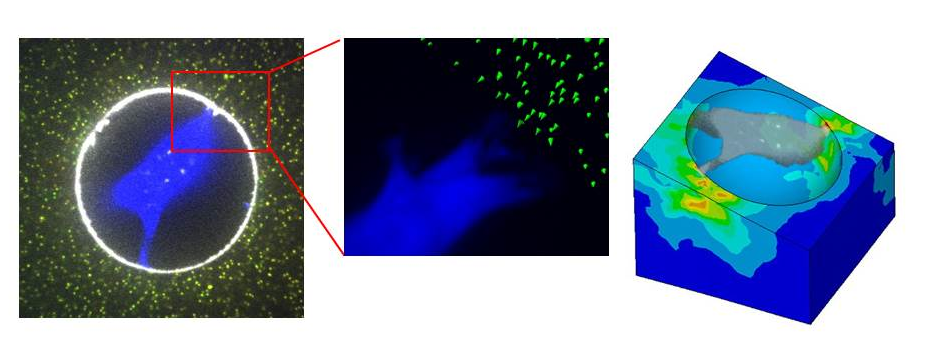Selected Research Projects
- Fabricating Monodisperse Foam Scaffolds and Novel Materials by Microfluidics
- Morphology and organization of tissue cells in the monodisperse foam scaffolds
- Building Epithelial Tissues
- 3D Traction Force on a Negatively Curved Substrate
- Mechanics of Ordered Solid Foam
Fabricating Monodisperse Foam Scaffolds and Novel Materials by Microfluidics
Our lab has invented a simple, inexpensive method to fabricate scaffolds of monodisperse ordered pores. This technology has been transferred to Bio-byblos Biomedical Company. We have engineered several types of microfluidic device suited for fabricating scaffolds made of hydrogels containing alginate, gelatin, and polyacrylamide.

Monodisperse foam scaffold fabrication. (Left to Right) Monodisperse liquid foam is generated by a microfluidic device self-assembled into crystalline order. The liquid foam is gelled into solid foam; the bubbles become topologically closed pores in the solid foam. Finally, the closed-pore solid foam opens via degassing under vacuum while immersed in liquid solution. The open-cell solid foam is treated with appropriate chemistry for use as a scaffold for 3D cell culture.

In addition to foam scaffolds, we employ similar strategy of biphasic flow to generate microspheres. We continue to design new 3D microenvironments to elucidate the role of dimensionality in cell culture.
Morphology and Organization of Tissue Cells in Monodisperse Foam Scaffolds
Cells of distinct tissue types cultured in our foam scaffolds display appropriate physiological, morphological and functional characteristics: epithelial cells form cyst-like structures and polarized inside pores, myoblasts adopt a tubular structure and fuse into myotubes, and fibroblasts, which reside in connective tissues, exhibit a wide variety of morphologies. Although the foam scaffolds do not resemble the extracellular matrix of native muscle and connective tissues, the cells preserve their characteristic morphologies in the foam scaffolds. Scaffolds with uniform pores can thus provide a platform for systematic study of 3D cell-matrix interactions and a rich set of cellular behaviors

Comparison of cells in spherical pores (top). (a) Mardin-Darby Canine Kidney cells form confluent layer in the pore. (b) C2C12 myoblasts differentiate into a myotube in the scaffold. (c) 3T3 fibroblast exhibits spindle morphology.
Building Epithelial Tissues
In the body, epithelial cells exhibit highly polarized organization and perform a wide variety of specialized functions such as transport, absorption, and secretion. Individual cell surfaces are divided into two domains, an apical domain and a basolateral domain, which are separated by tight junctions that circle around the apex of the cell. These domains often form a tubular (duct) or spherical (cyst) structure with a lumen inside. Little is understood about how tissues coordinate individual cells across space and time to function as an organized community. Currently, in vitro. cysts are grown using a bottom-up approach that relies on self-organization from a single cell. If we understand the principles of tissue morphogenesis, we should be able to design an appropriate scaffold to generate cysts by a top-down approach.

Reconstructed image of a cyst with nuclei (cyan) and primary cilia (yellow)
3D Traction Force on a Negatively Curved Substrate
Measuring traction forces exerted by cells on elastic substrates is crucial to establishing a quantitative understanding of the regulation of cell adhesions, morphology, and migration. We are currently developing a strain-based method to measure 3D traction force on a negatively curved surface. The strain field is computed by tracking fiducial markers embedded in the scaffold, and then the stress field is calculated by the finite element method.

Measuring traction force. (Left) Micrograph of a cell in a negatively curved substrate, with beads serving as fiducial markers. (Middle) Tracking bead movement near a cell extension. (Right) The resulting traction stress map.
Mechanics of Ordered Solid Foam
Solid foam, also known as "cellular solid", which is an important class of engineering materials consists of an assembly of cells with solid edges or faces that are packed together to fill space. These materials are abundant in daily life; natural cellular materials include wood, cork, cancellous bone, and so on. The manmade cellular materials are widely used as thermal insulation, battery electrodes, cushions, shock absorbers, structural supports, and insulators. It is useful and common material and yet it is under-studied subject. The mechanical properties of solid foams are determined by the cell structure and by the mechanical behaviors of the solid. Despite the ubiquity of these materials, there is lack of research that includes both theoretical models describing real samples and experimental observations of well-controlled components for comparison with theoretical models. More efficient utilization of foam materials requires a detailed understanding of their mechanical behaviors. We are engineering an ideal sample for microscopic observation and macroscopic measurement of mechanical properties such as the Young’s modulus, storage modulus, and Poisson Ratio. our investigations will yield fundamental knowledge of this class of materials and motivate future light-weight material development and research.